
The European Commission has announced Bjarke Ingels Group as the winner of an international competition for the design of the body’s Joint Research Center in Seville, Spain. The competition, which saw 66 offices bidding, was for a 9,900-square-meter (106,600-square-foot) building with 12 research units, supporting facilities, and a mix of public and private outdoor spaces.

BIG’s winning scheme was inspired by the shaded plazas and streets of Seville, which saw the firm cover the entire project site in a cloud of solar canopies sheltering the research building, plaza, and garden. The canopies are composed of square lightweight PV sheets supported by a “forest” of slender columns, creating a roof form which steps down from the center towards the site’s perimeter.
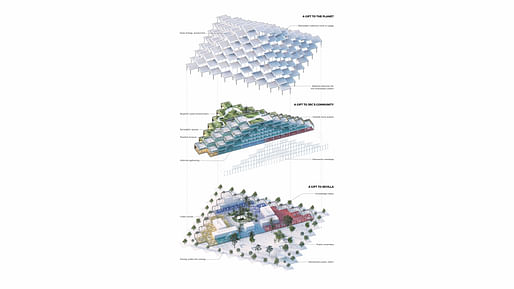
Beneath the canopy, the building sits diagonally on the rectangular site to more naturally connect with the riverfront and prominent market promenades. The diagonal form further serves to create two outdoor spaces on either side of the building’s length: one for the public and one exclusively for the building occupants.

Reflecting the exterior roofscape, the building’s floorplates step upwards as the building ascends towards the center, creating a series of terraces and shaded outdoor breakout, recreational, and meeting spaces. The scheme’s public functions, including dining, a conference center, and social spaces are placed on the ground floor, while offices and research units are placed on upper floors to enhance privacy and security.
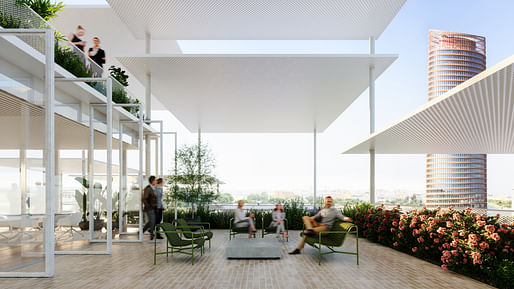
All levels of the building are connected by two diagonal voids, encouraging physical movement and social interaction. Meanwhile, collaborative workplaces are positioned to face the active plaza, while deep-focus workplaces face the more tranquil garden.
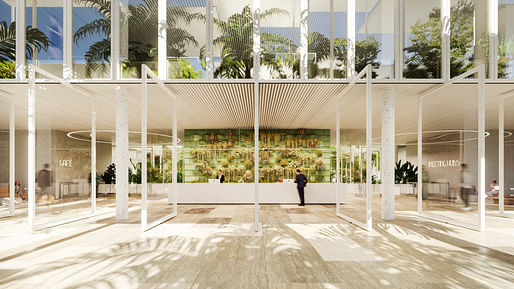
The scheme has been designed to accommodate natural cross ventilation and controlled light, aided by a shallow floorplate and the pergola’s shading. The scheme also prioritizes locally sourced materials such as limestone, wood, and ceramic tiling. Recycled steel is used for the external pergola, while the building’s “low-carbon concrete” structure will use 30% less CO2 emissions than is typical, the team says. The design also seeks to create a comfortable microclimate of gardens, local greenery, and water elements to reduce the heat island effect.
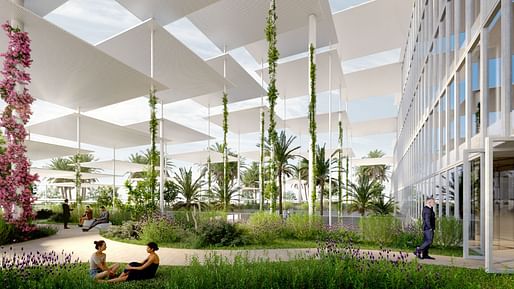
“With our design for the Joint Research Centre in Seville, more than anything, we have attempted to allow the sustainable performance of the building to drive an architectural aesthetic that not only makes the building perform better but also makes it more inhabitable and more beautiful - a new Andalusian environmental vernacular,” said Bjarke Ingels about the proposal. "Having started my studies as an architect in Andalusia and later returning to ETSAB in Barcelona, to now having a 50-person BIG office in Barcelona, this project feels like coming full circle.”

Land Art Generator Initiative 2025 Fiji: Climate Resilience for Island Communities
Register/Submit by Mon, May 5, 2025
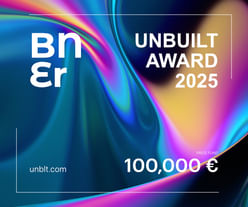
100,000 € Prize / Buildner's Unbuilt Award 2025
Register by Thu, Oct 30, 2025
Submit by Thu, Nov 20, 2025

Museum of Emotions / Edition #6
Register by Thu, Jan 23, 2025
Submit by Tue, Apr 29, 2025
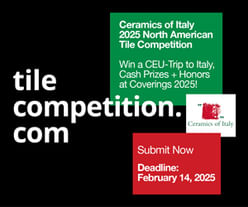
Ceramics of Italy Tile Competition
Register/Submit by Fri, Feb 14, 2025
2 Comments
Lmao those diagrams. A true gift to the planet will be bjarke never building anything ever again
gimmick architecture doesn’t have a long shelf life.
doesn’t reveal anything new over time, you see the trick on day one and that’s it.